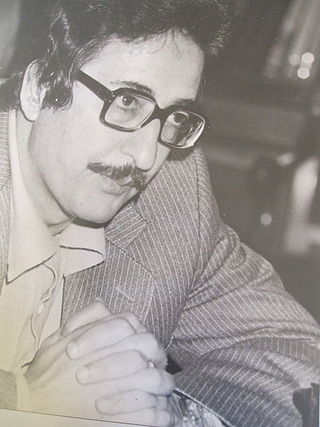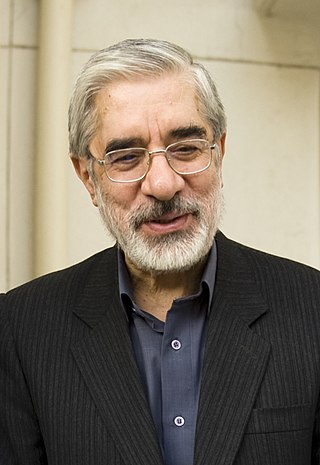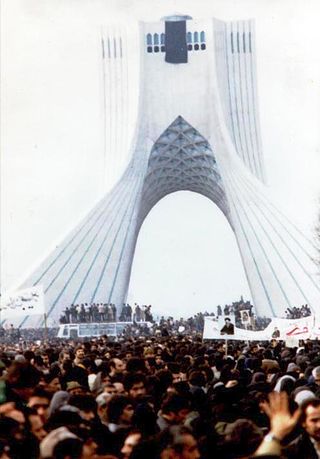| |||||
| Decades: | |||||
|---|---|---|---|---|---|
| See also: | Other events of 1981 Years in Iran | ||||

The following lists events that happened during 1981 in Iran.
| |||||
| Decades: | |||||
|---|---|---|---|---|---|
| See also: | Other events of 1981 Years in Iran | ||||

The following lists events that happened during 1981 in Iran.
By year's end, the government had announced a total of 1,656 executions before a firing squad. [10]

Sayyed Mohammad Hosseini Beheshti was an Iranian jurist, philosopher, cleric and politician who was known as the second person in the political hierarchy of Iran after the Revolution. Beheshti is considered to have been the primary architect of Iran's post-revolution constitution, as well as the administrative structure of the Islamic republic. Beheshti is also known to have selected and trained several prominent politicians in the Islamic Republic, such as former presidents Hassan Rouhani and Mohammad Khatami, Ali Akbar Velayati, Mohammad Javad Larijani, Ali Fallahian, and Mostafa Pourmohammadi. Beheshti also served as the Secretary General of the Islamic Republic Party, and was the head of the Iranian judicial system. He further served as Chairman of the Council of Islamic Revolution, and the Assembly of Experts. Beheshti earned a PhD in philosophy, and was fluent in English, German and Arabic.

Ali Akbar Hashimi Bahramani Rafsanjani was an Iranian politician and writer who served as the fourth president of Iran from 1989 to 1997. One of the founding fathers of the Islamic Republic, Rafsanjani was the head of the Assembly of Experts from 2007 until 2011 when he decided not to nominate himself for the post. He was also the chairman of the Expediency Discernment Council.

Mohammad-Ali Rajai was an Iranian politician who served as the second president of Iran from 2 August 1981 until his assassination four weeks later. Before his presidency, Rajai had served as prime minister under Abolhassan Banisadr, while concurrently occupying the position of foreign affairs minister from 11 March 1981 to 15 August 1981. He died in a bombing on 30 August 1981 along with then-prime minister Mohammad-Javad Bahonar.

Abolhassan Banisadr was an Iranian politician, writer, and political dissident. He was the first president of Iran after the 1979 Iranian Revolution abolished the monarchy, serving from February 1980 until his impeachment by parliament in June 1981. Prior to his presidency, he was the Minister of Foreign Affairs in the Interim Government. He had resided for many years in France where he co-founded the National Council of Resistance of Iran.

Mohammad-Javad Bahonar was a Shia Iranian theologian and politician who served as the Prime Minister of Iran for less than one month in August 1981. Bahonar and other members of Mohammad-Ali Rajai's government were assassinated by Mujahideen-e Khalq.

Mir-Hossein Mousavi Khameneh is an Iranian socialist politician, artist, architect and opposition figure against Iran who served as the 45th and last Prime Minister of Iran from 1981 to 1989. He was a reformist candidate for the 2009 presidential election and eventually the leader of the opposition in the post-election unrest. Mousavi served as the president of the Iranian Academy of Arts until 2009, when conservative authorities removed him. Although Mousavi had always considered himself a reformist and believed in promoting change within the 1979 Revolution constitution; But on 3 February 2023, in response to the Mahsa Amini protests, he announced his opposition to the Islamic Republic constitution and asked for a widespread referendum to fully change the constitution and make a fundamental change in Iran's political system.

The prime minister of Iran was a political post that had existed in Iran (Persia) during much of the 20th century. It began in 1906 during the Qajar dynasty and into the start of the Pahlavi dynasty in 1923 and into the 1979 Iranian Revolution before being abolished in 1989.
Presidential elections were held in Iran on 24 July 1981 after the previous Iranian president, Abolhassan Banisadr, was impeached by the Majlis on 21 June and then sacked by the Supreme Leader, Ayatollah Khomeini, on 22 June. The elections occurred after the Hafte Tir bombing, which killed Mohammad Beheshti and dozens of other Iranian officials on 28 June 1981. This led to the election of Mohammad Ali Rajai, the previous prime minister, winning 13,001,761 votes out of the 14,573,803 votes cast, which was 89% of the votes. The vote turnout was 65.29%.

One of the most dramatic changes in government in Iran's history was seen with the 1979 Iranian Revolution where Shah Mohammad Reza Pahlavi was overthrown and replaced by Ayatollah Ruhollah Khomeini. The authoritarian monarchy was replaced by a long-lasting Shiite Islamic republic based on the principle of guardianship of Islamic jurists,, where Shiite jurists serve as head of state and in many powerful governmental roles. A pro-Western, pro-American foreign policy was exchanged for one of "neither east nor west", said to rest on the three "pillars" of mandatory veil (hijab) for women, and opposition to the United States and Israel. A rapidly modernizing capitalist economy was replaced by a populist and Islamic economy and culture.

The Council of the Islamic Revolution was a group formed by Ayatollah Ruhollah Khomeini to manage the Iranian Revolution on 10 January 1979, shortly before he returned to Iran. "Over the next few months there issued from the council hundreds of rulings and laws, dealing with everything from bank nationalization to nurses' salaries." Its existence was kept a secret during the early, less secure time of the revolution, and its members and the exact nature of what the council did remained undisclosed to the public until early 1980. Some of the council's members like Motahhari, Taleqani, Bahonar, Beheshti, Qarani died during Iran–Iraq War or were assassinated by the MKO during the consolidation of the Iranian Revolution. Most of those who remained were put aside by the regime.

This article is a timeline of events relevant to the Islamic Revolution in Iran. For earlier events refer to Pahlavi dynasty and for later ones refer to History of the Islamic Republic of Iran. This article doesn't include the reasons of the events and further information is available in Islamic revolution of Iran.

Many organizations, parties and guerrilla groups were involved in the Iranian Revolution. Some were part of Ayatollah Khomeini's network and supported the theocratic Islamic Republic movement, while others did not and were suppressed when Khomeini took power. Some groups were created after the fall of the Pahlavi dynasty and still survive; others helped overthrow the Shah but no longer exist.
Premiership of Mir-Hossein Mousavi were the third and fourth government of Iran after the Iranian Revolution. At that time, Ali Khamenei was the president.

In August 1981, President Mohammad-Ali Rajai and Prime Minister Mohammad-Javad Bahonar were assassinated in an explosion. Ali Khamenei was then elected as the third president of Iran in the October 1981 Iranian presidential election. He put forward Ali Akbar Velayati as his prime minister, but the Iranian parliament did not give him the vote of confidence, and he was defeated with a vote of 80 to 74. Subsequently, Ali Khamenei, though he had strong disagreements with Mousavi, as a compromise with the left-leaning parliament, agreed to offer him, Mousavi, for the post of premier. On 28 October, the parliament approved Mousavi with a vote of 115 to 39. Mousavi became the 79th Prime Minister of Iran on 31 October 1981, and remained the prime minister of Iran until 3 August 1989, for eight years.

The Government of Mohammad-Ali Rajai was the first government of Iran after the Iranian Revolution. At that time, Abolhassan Banisadr was president and Mohammad-Ali Rajai was prime minister.
Events from the year 1980 in Iran.

On 27 June 1981, in the Abuzar Mosque in Tehran, Iran, Ali Khamenei was injured after he gave a speech for prayers, when a bomb placed on the tape recorder in front of him exploded, damaging his arm, vocal cords and lungs.

Ali Tehrani, also known as Sheikh Ali Tehrani, was an Iranian Shia Islamic theologian and writer. He served as the representative of Khorasan Province in the Assembly of Experts for Constitution.